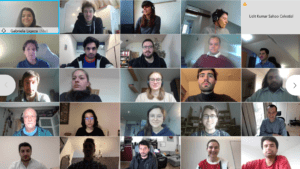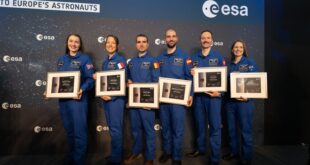 Nine IGLUNA students presented the initial phase of their lunar mission “SCALE” to a team of ESA specialists involved in the preparation and assessment of the agency’s future space missions. The mission brings together three experiments developed during the 2020 edition of IGLUNA by students from the universities of Berlin, Aachen and Warsaw. Their goal? To send their experiments by 2028 to the Moon for a 14-day mission.
Nine IGLUNA students presented the initial phase of their lunar mission “SCALE” to a team of ESA specialists involved in the preparation and assessment of the agency’s future space missions. The mission brings together three experiments developed during the 2020 edition of IGLUNA by students from the universities of Berlin, Aachen and Warsaw. Their goal? To send their experiments by 2028 to the Moon for a 14-day mission.
Over the past three months, IGLUNA students have been assisted by experts from the Concurrent Design Facility at the European Space Agency (ESA) to plan the phase 0 of their lunar mission. The mission, named “SCALE”, brings together the projects SAMPLE (Warsaw University of Technology), AMPEX (RWTH Aachen University) and Celestial (Technical University of Berlin). The aim of the mission is to operate for 1 lunar day (i.e. 14 terrestrial days) in order to test a module for the automated cultivation of plants, a device to produce fibres from lunar soil and a lunar communication system. SCALE will operate aboard a Lunar Lander and the experiments are planned to be brought back to Earth when the mission is complete.
The phase 0 of a space mission corresponds to the evaluation of needs and constraints and the analysis of the feasibility – technical and strategical – of the mission. The students worked on the first key aspects of the mission such as definition of the concept of operations, development schedule and financing of the project. They also had to choose the landing site and the model of the Lunar Lander. Finally, they adapted their modules to take into account the new technical constraints of the mission, such as mass, lunar temperatures and cosmic radiation.
At the heart of the future space missions

The review of the phase 0 was carried out by an ESA’s Concurrent Design Facility (CDF) team, hosting the technical experts supporting the preparation of the agency’s future space missions. The CDF brings together representatives of several space disciplines and evaluates on average between 15 and 20 mission studies per year. These studies are usually requested by internal ESA Programmes Directorates, space industry consortia or national space agencies.
Welcoming IGLUNA students to assist them in their lunar mission project was an unconventional activity for the CDF. The implementation of this mentoring programme was initiated following the wish of the Director General of ESA, Jan Wörner, to support the education of future European engineers and to encourage international and multidisciplinary missions. It also responds to the agency’s vision to establish a permanent lunar base by 2030 and to develop the technologies that will bring this project to life.
A step further for IGLUNA students
Coordinated by the Swiss Space Center, IGLUNA enables students from all over the world to develop and collaborate on innovative space technologies for one year. In March 2020, they were invited to submit their ideas to ESA for a lunar mission on the Open Space Innovation Platform (OSIP). The most advanced and scientifically valuable projects were then selected by the Concurrent Design Facility (CDF) appointed team and the Swiss Space Center. The students have since worked together on their mission until the final review by the CDF experts on the 10th and 15th of December 2020.





